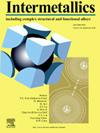Study on microstructure evolution and strengthening mechanism of CuFeNiCoSi biphase high-entropy alloy by co-alloying of high melting point elements Mo and Nb
IF 4.8
2区 材料科学
Q2 CHEMISTRY, PHYSICAL
引用次数: 0
Abstract
CuFeNiCoSiMoxNb(1-x) high entropy alloy coating (x = 0, 0.25, 0.5, 0.75, 1) was successfully prepared on P20 substrate by the laser cladding technology. The effects of x changes on microstructure, hardness, wear resistance and corrosion resistance of the coating were systematically studied. The results show that Nb tends to partition into the BCC phase, while Mo tends to partition into the FCC phase. CuFeNiCoSi coating has FCC + BCC biphase structure. When Nb element is added alone, the coating is composed of BCC + Laves phase, which is mainly precipitation strengthening and solid solution strengthening. When Mo element is added alone, the coating is composed of FCC + BCC+σ phase, and the strengthening mechanism is the same as that when Nb element is added alone. When Mo and Nb elements are added at the same time, the coating is composed of FCC + BCC + Laves phase, and the strengthening mechanism is mainly precipitation strengthening, solid solution strengthening and fine crystal strengthening. When x = 0.25, the grain size of the coating is the smallest, and the fine crystal strengthening effect is the strongest. With the increase of x, the hardness, wear resistance and corrosion resistance of the coating first increased and then decreased. When x = 0.25, the performance of the coating is the best.

高熔点元素Mo和Nb共合金化CuFeNiCoSi双相高熵合金的组织演变及强化机理研究
采用激光熔覆技术在P20衬底上成功制备了CuFeNiCoSiMoxNb(1-x)高熵合金涂层(x = 0, 0.25, 0.5, 0.75, 1)。系统研究了x的变化对镀层显微组织、硬度、耐磨性和耐蚀性的影响。结果表明:Nb倾向于分块成BCC相,Mo倾向于分块成FCC相;CuFeNiCoSi涂层具有FCC + BCC双相结构。单独添加Nb元素时,涂层由BCC + Laves相组成,以沉淀强化和固溶体强化为主。单独添加Mo元素时,涂层由FCC + BCC+σ相组成,强化机理与单独添加Nb元素时相同。同时添加Mo和Nb元素时,涂层由FCC + BCC + Laves相组成,强化机制主要为沉淀强化、固溶强化和细晶强化。当x = 0.25时,涂层的晶粒尺寸最小,细晶强化效果最强。随着x的增大,涂层的硬度、耐磨性和耐蚀性先增大后减小。当x = 0.25时,涂层的性能最好。
本文章由计算机程序翻译,如有差异,请以英文原文为准。
求助全文
约1分钟内获得全文
求助全文
来源期刊

Intermetallics
工程技术-材料科学:综合
CiteScore
7.80
自引率
9.10%
发文量
291
审稿时长
37 days
期刊介绍:
This journal is a platform for publishing innovative research and overviews for advancing our understanding of the structure, property, and functionality of complex metallic alloys, including intermetallics, metallic glasses, and high entropy alloys.
The journal reports the science and engineering of metallic materials in the following aspects:
Theories and experiments which address the relationship between property and structure in all length scales.
Physical modeling and numerical simulations which provide a comprehensive understanding of experimental observations.
Stimulated methodologies to characterize the structure and chemistry of materials that correlate the properties.
Technological applications resulting from the understanding of property-structure relationship in materials.
Novel and cutting-edge results warranting rapid communication.
The journal also publishes special issues on selected topics and overviews by invitation only.
 求助内容:
求助内容: 应助结果提醒方式:
应助结果提醒方式:


